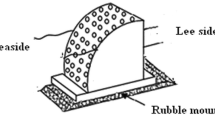Abstract
Breakwaters have been built throughout the centuries for the coastal protection and the port development, but changes occurred in their layout and criteria used for the design. Quarter circle breakwater (QBW) is a new type evolved having advantages of both caisson type and perforated type breakwaters. The present study extracts the effect of change in the percentage of perforations on the stable conditions of seaside perforated QBW by using various physical models. The results were graphically analyzed using dimensionless parameters and it was concluded that there is a reduction in dimensionless stability parameter with an increase in steepness of the wave and change in water depth to the height of breakwater structure. Multiple non–linear regression analysis was done and the equation for the best fit curve with a higher regression coefficient was obtained by using Excel statistical software—XLSTAT.











Similar content being viewed by others
Abbreviations
- S/D :
-
Spacing between perforations/diameter of perforations
- H i :
-
incident wave height
- D :
-
depth of water
- g :
-
acceleration due to gravity
- T :
-
wave period
- L :
-
wave length
- W :
-
weight of QBW per unit length
- h s :
-
height of structure
- γ :
-
weight density
- d/h s :
-
relative water depth
- H i /gT 2 :
-
incident wave steepness parameter
- W/γH i 2 :
-
stability parameter
References
Binumol S, Rao S, Hegde AV (2017) Wave reflection and loss characteristics of an emerged quarter circle breakwater with varying seaside perforations. J Inst Eng (India): Ser A Springer 98(3):311–315
Chaudhary B, Hazarika H, Nishimura N (2017) Effects of duration and acceleration level of earthquake ground motion on the behavior of unreinforced and reinforced breakwater foundation. Soil Dyn Earthq Eng 98:24–37
Chaudhary B, Hazarika H, Murakami A, Fujisawa K (2018a) Geosynthetic-sheet pile reinforced foundation for mitigation of earthquake and tsunami induced damage of breakwater. Geotext Geomembr 46:597–610
Chaudhary B, Hazarika H, Murakami A, Fujisawa K (2018b) Countermeasures for enhancing the stability of composite breakwater under earthquake and subsequent tsunami. Acta Geotech 13(4):997–1017
Chaudhary B, Hazarika H, Murakami A, Fujisawa K (2019) Development of resilient breakwater against earthquake and tsunami. Int J Geomech, ASCE 19 (1): 04018188–1 to 17
Hughes SA (1993) Physical models and laboratory techniques in coastal engineering advanced series on Ocean Engineering, World Scientific Singapore
Isaacson M (1991) Measurement of regular wave reflection. J Waterw Port Coast Ocean Eng 117(6):553–569
Jiang XL, Gu HB, Li YB (2008) Numerical simulation on hydraulic performances of quarter-circular breakwater. China Ocean Eng 22(4):585–594
Luwen Q, Zhang X, Jiang X, Qin Y (2013) Research on partial coefficients for the design of quarter-circular caisson breakwater. J Mar Sci Appl 12:65–71
Misra SC (2001) Uncertainty analysis in hydrodynamic tests. Proceedings, International Conference in Ocean Engineering, 200-207
Shi Y-J, Mi-ling W, Jiang X, Li Y-b (2011) Experimental researches on reflective and transmitting performances of quarter-circular breakwater under regular and irregular waves. China Ocean Eng 25:469–478
Xie SL, Li YB, Wu YQ, Gu HB (2006) Preliminary research on wave forces on quarter circular breakwater. Ocean Eng J 24(1):14–18
Acknowledgments
The authors are thankful to Director, NITK Surathkal and the Head of Applied Mechanics Department, NITK Surathkal for all the support and encouragement in the preparation of this paper.
Author information
Authors and Affiliations
Corresponding author
Additional information
Article Highlights
• Stability of perforated quarter circle breakwater based on physical models and empirical approaches is studied.
• An equation is developed for the stability parameter using the multiple nonlinear regression analysis.
Rights and permissions
About this article
Cite this article
Binumol, S., Rao, S. & Hegde, A.V. Multiple Nonlinear Regression Analysis for the Stability of Non-overtopping Perforated Quarter Circle Breakwater. J. Marine. Sci. Appl. 19, 293–300 (2020). https://doi.org/10.1007/s11804-020-00145-3
Received:
Accepted:
Published:
Issue Date:
DOI: https://doi.org/10.1007/s11804-020-00145-3




